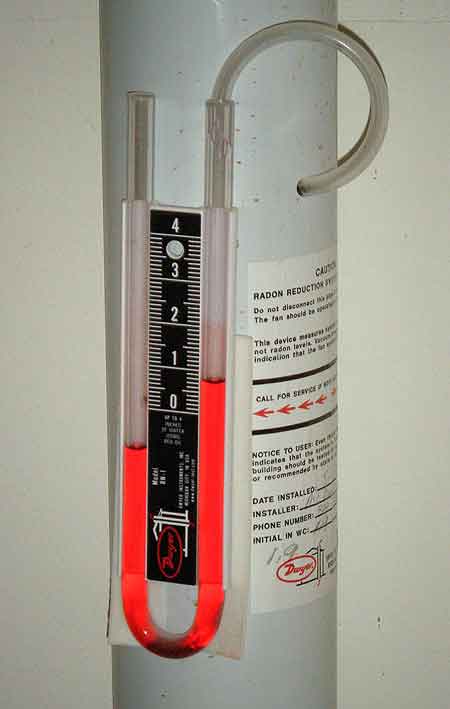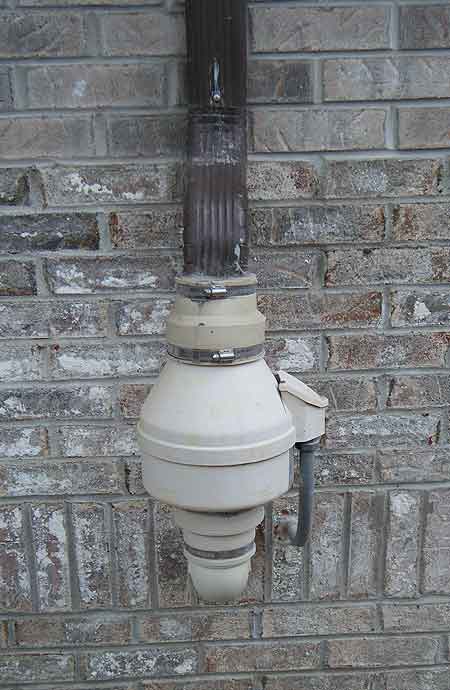Article and photos by Gregory Havel
According to the United States Environmental Protection Agency (EPA), radon is the leading cause of lung cancer among nonsmokers, and the second-leading cause of lung cancer overall. Radon is estimated to be responsible for about 21,000 lung cancer deaths each year.
Radon, a radioactive element, is an odorless, colorless gas. Radon-222 is the decay product of radium-226, its parent element. Both are part of the long decay chain for uranium-238. Since uranium is found everywhere in some quantity in the earth’s crust, radium-226 and radon-222 are present in almost all rock, soil, and water.
The amount of radon in the soil at any location depends on soil chemistry, which can vary greatly from one house to the next. The amount of radon that escapes from the soil to enter the air in the house depends on the weather, soil porosity, soil moisture, and the conditions within the house. Since modern and remodeled buildings are more tightly sealed than those of in the past, the exchange of outdoor with indoor air has been greatly reduced, allowing radon gas to accumulate, and this can become a problem.
If a homeowner has had the radon level in the air inside the house tested, and it is high enough to be considered unhealthy by EPA standards, there are several methods that will reduce the level of radon.

(1)
The most common of these is called active sub-slab suction, or sub-slab depressurization. In this method, one or more plastic pipes (like PVC sewer pipes) are inserted through the basement floor into the gravel or granular soil beneath the floor. The number of pipes needed depends on the strength of the radon source and the ease with which air can move through the soil under the floor. Photo 1 shows a suction pipe of a radon reduction system in a residential basement. The lower end passes through the concrete floor into the soil below. The other end passes to the right to the exterior of the building.

(2)
Photo 2 shows a close-up of the indicator on the suction pipe in photo 1. One end of the fluid-filled U-shaped tube is open to the atmosphere. The other end is connected by a flexible plastic tube to the interior of the suction pipe. The higher liquid level on the right side of the U-shaped tube shows that the air pressure in the suction pipe, and in the soil below the floor, is lower than the atmospheric pressure in the rest of the basement. Air and radon gas are moving through the soil, through the pipe, and out of the house, rather than into the basement.

(3)
Photo 3 shows the radon vent fan (to reduce the air pressure below the floor) connected on the exterior of the house to the suction pipe at the bottom, and to a vent pipe at the top which extends above the eaves of the house. The vent pipe is usually plastic, but sometimes downspout piping is used if the appearance of the installation is important.
If the structure has drain tiles around the foundation and a sump pit with a pump in the basement, these can be used to collect the radon gas. The suction pipe is inserted through the sealed cover on the sump pit rather than through the floor. The rest of this type of radon reduction system appears like the one in the photos. The sump pump has its own discharge pipe that does not interfere with the venting of the radon gas.
The basement walls and floor can be sealed together to keep the radon gas out in new homes in areas where radon is a known problem. However, this system is not always as effective as active sub-slab suction.
The absence of a radon-reduction system in a building does not mean that radon is not present. It may simply indicate that this structure has not yet been tested.
The presence of radon gas in a building during an incident is unlikely to cause responders any health effects because of the short time of exposure. Observing the presence of one of these systems during an incident should suggest that a long-term exposure could present a problem.
Radon gas in emergency responders’ residences can affect their health and that of their families. If you live in an area or neighborhood where radon is known to be a problem, a radon test kit would be a good investment. If you are planning to purchase a home, many financial institutions now require radon testing as part of the home inspection report, before closing the sale.
For detailed information on radon gas, its health effects, testing, and the ways it can be controlled in buildings, visit the U.S. EPA Web site http://www.epa.gov/radon or search the Internet for “radon.”
Download this article as a PDF HERE.
 Gregory Havel is a member of the Town of Burlington (WI) Fire Department; retired deputy chief and training officer; and a 30-year veteran of the fire service. He is a Wisconsin-certified fire instructor II, fire officer II, and fire inspector; an adjunct instructor in fire service programs at Gateway Technical College; and safety director for Scherrer Construction Co., Inc. Havel has a bachelor’s degree from St. Norbert College; has more than 30 years of experience in facilities management and building construction; and has presented classes at FDIC.
Gregory Havel is a member of the Town of Burlington (WI) Fire Department; retired deputy chief and training officer; and a 30-year veteran of the fire service. He is a Wisconsin-certified fire instructor II, fire officer II, and fire inspector; an adjunct instructor in fire service programs at Gateway Technical College; and safety director for Scherrer Construction Co., Inc. Havel has a bachelor’s degree from St. Norbert College; has more than 30 years of experience in facilities management and building construction; and has presented classes at FDIC.
MORE CONSTRUCTION CONCERNS

